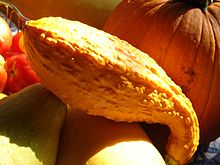Crookneck squash
| Cucurbita pepo 'Yellow crookneck' | |
|---|---|
 Crookneck squash along with other types of squash | |
| Species | Cucurbita pepo |
| Cultivar | Yellow crookneck |
| Origin | Eastern North America |
| Nutritional value per 100 g (3.5 oz) | |||||||||||||||||||
|---|---|---|---|---|---|---|---|---|---|---|---|---|---|---|---|---|---|---|---|
| Energy | 19 kcal (79 kJ) | ||||||||||||||||||
3.9 g | |||||||||||||||||||
| Dietary fiber | 1.0 g | ||||||||||||||||||
0.3 g | |||||||||||||||||||
1.0 g | |||||||||||||||||||
| |||||||||||||||||||
| Other constituents | Quantity | ||||||||||||||||||
| Water | 94 g | ||||||||||||||||||
| †Percentages estimated using US recommendations for adults,[1] except for potassium, which is estimated based on expert recommendation from the National Academies.[2] | |||||||||||||||||||
Crookneck squash, also known as yellow squash, is a cultivar of Cucurbita pepo,[3] the species that also includes some pumpkins and most other summer squashes. The plants are bushy[3] and do not spread like the plants of winter squash and pumpkin.[4] Most often used as a summer squash, it is characterized by its yellow skin (which may be smooth or bumpy)[4] and sweet yellow flesh, as well as its distinctive curved stem-end or "crooked neck".[5] It should not be confused with crookneck cultivars of Cucurbita moschata, such as the winter squash 'Golden Cushaw',[6] or the vining summer squash 'Tromboncino'.[3] Its name distinguishes it from another similar-looking variety of C. pepo, the straightneck squash, which is also usually yellow.[7][8][9] There is one similar non-edible C. pepo variety: C. pepo var. ovifera.[10]
Yellow crookneck squash are generally harvested immature, when they are less than two inches in diameter,[4][5] since the skin toughens and the quality degrades as the squash reaches full maturity.[11]
References
- ^ United States Food and Drug Administration (2024). "Daily Value on the Nutrition and Supplement Facts Labels". FDA. Archived from the original on 2024-03-27. Retrieved 2024-03-28.
- ^ National Academies of Sciences, Engineering, and Medicine; Health and Medicine Division; Food and Nutrition Board; Committee to Review the Dietary Reference Intakes for Sodium and Potassium (2019). Oria, Maria; Harrison, Meghan; Stallings, Virginia A. (eds.). Dietary Reference Intakes for Sodium and Potassium. The National Academies Collection: Reports funded by National Institutes of Health. Washington, DC: National Academies Press (US). ISBN 978-0-309-48834-1. PMID 30844154. Archived from the original on 2024-05-09. Retrieved 2024-06-21.
- ^ a b c "Zucchetta". Mount Vernon Northwestern Washington Research and Extension Center: Vegetable Research and Extension. Washington State University. Retrieved 10 May 2013.
- ^ a b c "Summer Squash". Watch Your Garden Grow. University of Illinois Extension. Retrieved 14 May 2013.
- ^ a b "Summer Squash" (PDF). University of the District of Columbia Cooperative Extension Service. Retrieved 14 May 2013.
- ^ Phillips, R.; Rix, M. (1993). Vegetables. New York: Random House.
- ^ Saade, R. Lira; Hernández, S. Montes. "Cucurbits". Purdue Horticulture. Retrieved September 2, 2013.
- ^ "Cucurbita pepo". Missouri Botanical Garden. Retrieved September 2, 2013.
- ^ Heistinger, Andrea (2013). The Manual of Seed Saving: Harvesting, Storing, and Sowing Techniques for Vegetables, Herbs, and Fruits. Portland, OR: Timber Press. p. 278. ISBN 978-1-60469-382-9.
- ^ Decker, Deena S.; Wilson, Hugh D. (1987). "Allozyme Variation in the Cucurbita pepo Complex: C. pepo var. ovifera vs. C. texana". Systematic Botany. 12 (2). American Society of Plant Taxonomists: 263–273. doi:10.2307/2419320. JSTOR 2419320.
- ^ "Summer and Winter Squash". Utah State University Cooperative Extension. Archived from the original on 10 June 2013. Retrieved 14 May 2013.
External links
 Media related to Cucurbita pepo crookneck group at Wikimedia Commons
Media related to Cucurbita pepo crookneck group at Wikimedia Commons- National Nutrient Database for Standard Reference

